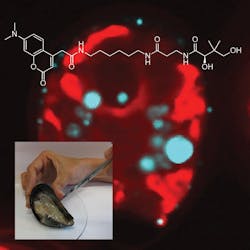Fluorescence approach overcomes obstacles to probe seafood for safety
A fluorescent probe developed at the University of California at San Diego could enable real-time toxin screening of seafood.1 The technology targets dinoflagellates-organisms commonly found in sea water that are associated with harmful algae and bacteria accumulation, which can lead to toxins transferring into shellfish tissue. While symbiotic bacteria has long been suspected of playing a key role in the biosynthesis of toxins from dinoflagellates, this toxin-bacteria interaction was never confirmed until Michael Burkart and colleagues developed a fluorescence microscopy tool to screen shellfish for toxin-producing dinoflagellates
The team fluorescently labeled a protein that is taken up by cells responsible for biosynthesising the toxin, okadaic acid. In-vivo studies show that samples producing the toxin glow blue under the microscope. The samples that provide a positive response to the probe also show signs of symbiotic bacteria in the cell walls, confirming the toxin-bacteria association.
Using this information, the researchers developed an assay to select mussels that contain live toxin-producing dinoflagellates at different stages of infection by counting fluorescing cells. Imaging shellfish during dinoflagelate infection detects okadaic acid much quicker than present techniques, which can detect dinoflagellates only once they have been fully absorbed into the shellfish tissue.
The biosynthesis of these compounds was historically "untouchable because of the enormous size of dinoflagellate genomes, which are much larger than human genomes, and the lack of genetic systems, which has frustrated commonly used approaches," says Jon Clardy, a pharmacology researcher at the Harvard Medical School (Cambridge, MA).
Burkhart says that if this method can be applied to an automated system, it could prove useful for aquafarming. And, he adds, "one could imagine a mobile phone application that would let you see if your crop or plate of oysters is safe for consumption."
1. C.P. Reyes et al., Chem. Commun. (2010), doi: 10.1039/C0CC02876B
More BioOptics World Current Issue Articles
More BioOptics World Archives Issue Articles

